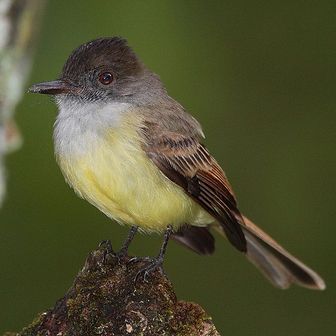Dusky-capped Flycatcher
Adult Dusky-capped Flycatchers are 18cm long and weigh 19.4g. The upperparts are brown, with a blackish head and short crest. The breast is grey and the belly is bright yellow. The brown tail feathers and wings have paler outer webs. The sexes are similar, but young birds have rufous edgings to the wings and tail.

Original source: Own work
Author: MdfOther versionsImage:Myiarchus-tuberculifer-002.jpg (edited)
Permission: GNU Free Documentation License
The Dusky-capped Flycatcher is classified as Least Concern. Does not qualify for a more at risk category. Widespread and abundant taxa are included in this category.
Distribution of the Dusky-capped Flycatcher in North and Middle America. The plaintive, whistled call of the Dusky-capped Flycatcher is a common sound in oak and pine woodland in southeastern Arizona and southwestern New Mexico as pairs maintain contact within dense foliage. This call is heard throughout this taxon’s extensive range, from southwestern United States to northwestern Argentina. The Dusky-capped Flycatcher is a diverse taxon with 13 subspecies. More
The Dusky-capped Flycatcher, Myiarchus tuberculifer, is a passerine bird in the tyrant flycatcher family. It breeds in forest and other woodland from southern Arizona, as well as the Chisos Mountains, Texas, south to northern Argentina and on Trinidad. It is resident in most of its range, but American breeders retreat to Mexico in winter. Adult Dusky-capped Flycatchers are 18cm long and weigh 19.4g. The upperparts are brown, with a blackish head and short crest. The breast is grey and the belly is bright yellow. More
Dusky-capped Flycatchers (Myiarchus tuberculifer) are common here in southeastern Arizona in oak-pine woodlands and riparian canyons in the mountains from April until sometime in September. Here in the United States, Dusky-capped Flycatchers are usually only found in southeastern Arizona and southwestern New Mexico. I observed this Dusky-capped Flycatcher in Madera Canyon, Arizona in May of 2007. More
Dusky-capped Flycatcher which has been present at Nearys Lagoon in Santa Cruz since 9 December 1997. I was joined by Ron Haaseth of Michigan, Adam Winer and Don Schmoldt. We entered via the paved path from California Street off Bay Street and checked out the area where the fence is covered with flowering German Ivy. We had no luck at first and spread out covering different areas. More
Dusky-capped Flycatcher 23 November 2005 at Arcata, HUM Photo More
The Dusky-capped Flycatcher has a large range, estimated globally at 11,000,000 square kilometers. It is native to Mexico and the United States as well as many of the nations of Central and South America and prefers forest and wetlands ecosystems, though it has been known to reside in plantations and degraded former forests. More
The dusky-capped flycatcher is found from southeastern Arizona and southwestern New Mexico south into South America. Birds in the northern parts this range may migrate south in the winter. . Habitat The dusky-capped flycatcher is found in oak-pine woodlands and thickets and river canyons. Diet Dusky-capped flycatchers primarily eat insects and some fruits and berries. More
(Tyrannidae) Dusky-capped Flycatcher Head Illustration Head * Bill Shape: All-purpose * Eye Color: Dark brown. More
The Dusky-capped Flycatcher is best separated from other confusingly similar Myiarchus species by its smaller size, blackish head, and its call, a sorrowful, descending, whistled peeur or wheeeeeu. This species is insectivorous and catches its prey by flycatching amongst the middle branches of trees. Fruits such as from Gumbo-limbo (Bursera simaruba), and less frequently from Cymbopetalum mayanum (Annonaceae) are sometimes also eaten, particularly in winter. More
The Dusky-capped Flycatcher, Myiarchus tuberculifer, is a passerine bird in the tyrant flycatcher family. Distribution / Range: It breeds in forest and other woodland from southern Arizona, as well as the Chisos Mountains, Texas, south to northern Argentina and on Trinidad. It is resident in most of its range, but American breeders retreat to Mexico in winter. More
Dusky-capped Flycatcher determination Similar species Tyrannidae Amazonian Royal Flycatcher | Bearded Tachuri | Black-capped Becard | Black-chested Tyrant | Black-crowned Tityra | Black-tailed Tityra | Boat-billed Flycatcher | Boat-billed Tody-Tyrant | Bran-coloured Flycatcher | Brown-crested Flycatcher | Cinereous Becard | Cinereous Mourner | Cinnamon Attila | Cinnamon-crested Spadebill | Cliff Flycatcher | Common Tody-Flycatcher | Double-banded Pygmy-tyrant | Drab Water-Tyrant More
Dusky-capped Flycatcher calls and song? (at 17s) Myiarchus tuberculifer (0:24) Todd Mark XC11572 19-07-2006, Mexico Dusky-capped Flycatcher song Myiarchus tuberculifer (0:04) Todd Mark XC11573 19-07-2006, Mexico Dusky-capped Flycatcher song Myiarchus tuberculifer (0:31) J. C. More

Original source: Darrin OBrien
Author: Darrin OBrien
Permission: Some rights reserved
Family : Tyrannidae
Genus : Myiarchus
Species : tuberculifer
Authority : (D'Orbigny & Lafresnaye, 1837)
